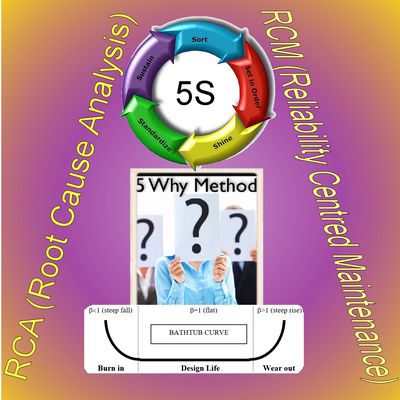Types of Maintenance Philosophies and Methods
3. Types of Maintenance Philosophies and Methods.
3.1 Equipment Reliability.
This topic is provided by – Michael Drew Director Arms Reliability Engineers reliability.com.au (This section has been edited.)
The focus of maintenance has changed from repairing equipment to keeping it running for longer between breakdowns. This requires more consideration of how to get longer running life between repairs, i.e., higher reliability, on a machine. To accomplish this a number of ‘tools’ have been invented and developed to allow maintainers to pinpoint problems and fix them. In this article three of the most effective ‘tools’ will be introduced. Root cause analysis, Weibull analysis and lifecycle simulation can be used to help organizations achieve proactive approaches to maintenance or adopt a “reliability-based approach” to maintenance.
Failure Patterns and Failure Modes
The initiation of a failure has been found to follow one of the six probability patterns shown in Figure No. 1. Evidence from the airline industry indicates that patterns D, E and F represent 89% of failures, with pattern F alone representing 68%. The values vary with different industries, but patterns D, E and F dominate. What the shapes highlight is that for most equipment, failure is not age related but can occur at any time. Failures can happen early in the equipment’s life or at any time in its life. Most failures have nothing to do with the age of the equipment.
A piece of equipment can only fail in a limited number of ways. The ways in which it can fail are known as its ‘failure modes’. The RCM process finds the likely failure modes and lets people decide about what to do to detect them early on, so the problem can be corrected before failure. Where the consequences of a failure are unimportant the equipment is left to run to destruction and is then replaced. Where the consequence of failure is important, measures are put into place to prevent failure. This includes condition monitoring, physical inspection, and regular overhauls. If necessary, the equipment is redesigned to remove the failure mode.
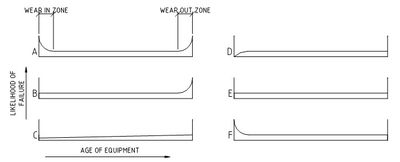
Root Cause Analysis
Improving existing plant performance requires the elimination of repeat failures or emerging failures. Root Cause Analysis (RCA) is undertaken as a search for the “Root Cause” of the problem. Effective RCA is really about seeking effective solutions that control the causes of problems. Like a detective we look for causes from the effects. Each cause produces the next effect. When we define a problem and begin looking for causes, we ask why of the effect, and answer with a cause. Effects become causes as we continue to ask why, and a cause-and-effect chain is established. The solution we select is the one that is attached to one of the causes that prevents the problem from recurring.
Understanding the cause-and-effect relationships of equipment and operational problems, is an essential part of an effective maintenance program. The best way to institutionalize RCA is to train all levels of an organization, so that seeking effective solutions is applied at the workplace and capturing “good” failure data for analysis is a normal requirement.
Life Data Analysis
Waloddi Weibull invented the Weibull distribution in 1937 while comparing death rates in different population groups.

It is now one of the most used methods for fitting equipment life data and has been used extensively in the aviation industry. The essence of Weibull’s work was to discover he could represent the Bathtub Curve of Figure No. 2 using one mathematical formula. The three zones of the bathtub curve can be represented using Weibull parameters beta (shape parameter), eta (life) and gamma (location).
Understanding the Weibull shape parameters provides the owners, users, and maintainers of equipment with a tool to predict the behavior of engineering components and select effective maintenance strategies.
β<1 implies infant mortality. Electronic and mechanical components often have high failure rates initially. Some components are ‘burnt in’ prior to use, others require careful commissioning after installation.
β=1 implies random failures. These failures are independent of time where an old part is as good as a new part. Maintenance overhauls are not appropriate. Condition monitoring and inspection are strategies used to detect the onset of failure and reduce the consequences of failure.
1<β<4 implies early wear out. Failures of this type are not normally expected within the design life. Failure mechanisms such as corrosion, erosion, low cycle fatigue and bearing failures fall in this range. Maintenance often involves a periodic rework or life extension task.
β>4 these are wear out or end of life failures. They should not appear within the design life. Appropriate maintenance is often renewal. An ideal profile for equipment is to have a negligible failure probability throughout its design life followed by a steep b where the replacement age can be predicted. Age related failures include stress corrosion cracking, creep, high cycle fatigue, and erosion.
Today Weibull analysis is commonly being used to predict safe intervals for operation in applications such as warranty periods, shutdown intervals and increasingly in setting maintenance and inspection intervals. With more sophisticated CMMS in use, the collection of failure mode data is more reliable and data analysis can be handled electronically.
Many organizations have been keeping records of failures manually or in computer systems, but not using the data in any useful way. Failure data is the best source of reliability information available. It has relevance and is easy for site people to relate their own experience to. By transforming it into useful information from which failure forecasts can be made it can then be used to model the benefits of alternative strategies or to analyze the reliability of current systems and the capacity to meet operating needs.
Life Cycle Simulation
Having determined the Weibull parameters that best represent failure mode behavior, they can be used to simulate performance over extended periods of time. Modern simulation packages involve a simulation engine that generates random numbers in accordance with the Weibull parameters over a specified system lifetime. Used in conjunction with Reliability Centered Maintenance (RCM) principles, the process of selecting maintenance and inspection intervals becomes a process of playing “what if” by comparing different reliability strategies.
ARMS Reliability Engineers provide training in the use of these methods and can assist companies with introduction of the methodologies into their organizations. For improving maintenance decisions and optimizing plant up-time see reliability.com.au for more information.
3.2 RCA (Root Cause Analysis).
Root Cause Analysis (RCA) is a step-by-step method that leads to the discovery of a fault’s first or root cause. Every equipment failure happens for several reasons. There is a definite progression of actions and consequences that lead to a failure. An RCA investigation traces the cause-and-effect trail from the end failure back to the root cause. Much like a detective solving a crime.
Overview of the RCA Process
The method brings a team of 3 to 6 knowledgeable people together to investigate the failure using evidence left behind from the fault. The team brainstorms to find as many causes of the fault as possible. By using what evidence remained after the fault, and through discussions with people involved in the incident, all the non-contributing causes are removed, and the contributing causes retained.
A fault tree is constructed starting with the final failure and progressively tracing each cause that led to the previous cause. This continues till the trail can be traced back no further. Each result of a cause must clearly flow from its predecessor (the one before it). If it is clear, that a step is missing between causes, it is added in and evidence looked for to support its presence.
Once the fault tree is completed and checked for logical flow the team then determines what changes to make to prevent the sequence of causes and consequences from again occurring.
Preventing Reoccurrence of the Failure
It is not necessary to prevent the first, or root cause, from happening. It is merely necessary to break the chain of events at any point and the final failure cannot occur. Often the fault tree leads to an initial design problem. In such a case redesign is necessary. Where the fault tree leads back to a failure of procedures it is necessary to either address the procedural weakness or to install a method to protect against the damage caused by the procedural failure. Below is a sample fault tree for the moral story of the kingdom lost because of a missing horseshoe nail.
An RCA Example with Cause Tree
The story is told that before an important battle a king sent his horse with a groomsman to the blacksmith for shoeing. But the blacksmith had used all the nails shoeing the knight’s horses for battle and was one short. The groomsman told the blacksmith to do as good a job as he could. But the blacksmith warned him that the missing nail may allow the shoe to come off. The king rode into battle not knowing of the missing horseshoe nail. In the midst of the battle, he rode toward the enemy. As he approached them the horseshoe came off the horse’s hoof causing it to stumble. The king fell to the ground. The enemy was quickly onto him and killed him. The king’s troops saw the death, give up the fight and retreated. The enemy surged onto the city and captured the kingdom. The kingdom was lost because of a missing horseshoe nail.
The cause tree below explains step-by-step how the events leading to the king’s death unfolded. Notice that two separate events ‘branches’ had to occur together for the sequence to continue to the fateful end. If any of the causes could have been prevented, then the kingdom would have been safe.
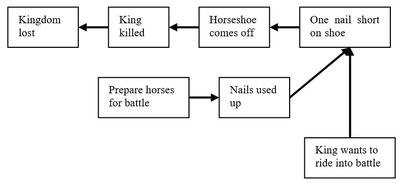
3.3 RCM (Reliability Centred Maintenance).
Reliability Centered Maintenance is one of the great developments in asset management. It is a methodology which studies a piece of plant or equipment in detail, predicts how it can fail, and puts into place the best maintenance strategy to prevent failure, or minimize losses from failure.
Loss of Function and Equipment Failure
A thing fails when it can no longer perform its intended duty. When a pump (or any equipment) cannot do its duty at the designed rate it has a loss of function. If some product is still coming through, people may decide it is sufficient and leave it in service a while longer. Whenever equipment does not satisfy the minimum duty requirement it is considered to have failed. RCM provides a way to detect loss of function before failure.
The aim of Reliability Centered Maintenance is to ...
- Use equipment and process-knowledgeable people to work out how many ‘reasonably likely’ ways a piece of equipment can loose its function.
- Use production and process-knowledgeable people to determine the effects and consequences resulting from each loss of function.
- Decide if the consequences of a failure need to be prevented.
- Use equipment, process, and maintenance-knowledgeable people to come up with effective proactive methods of preventing the failure or agree that no actions will be performed to prevent the failure.
- Use maintenance and operations-knowledgeable people to turn the method into situation-practical actions for the operators and maintainers.
- Buy the necessary equipment to detect the early onset of loss of function.
- Teach supervisors, leading hands, operators, and maintainers the correct use of the equipment.
- Let people know what to do once loss of failure is noted.
The RCM Process and Procedures
RCM uses a team of experienced and knowledgeable people to answers seven questions and come up with a strategy to maintain equipment function. The questions are:
· What are the functions and associated performance standards of the asset in its present operating context?
In what ways does it fail to fulfill its functions?
What causes each functional failure?
What happens when each failure occurs?
In what way does the failure matter?
What can be done to predict or prevent each failure?
What if a suitable proactive tack can not be found?
If the frequency of failure is unknown, research is conducted to find out how often the item is likely to break. Sources of failure data include original equipment manufacturers, equipment life databases, other same equipment users and other similar equipment.
The review process produces proactive tasks that offer effective means of detecting or preventing failure for each asset. The next step is to determine how often these tasks are to be performed so that loss of function is detected early enough to prevent complete failure. The test intervals are selected to be short enough to fit between the point-in-time failure is initiated and the point-in-time the item is considered failed. This requires us to predict the failure.
PM Optimization
PM Optimisation is a shorter version of RCM used on existing plants with sufficient history on known failure modes. Instead of starting with the first question, PM Optimisation starts with the third question because the failure modes for the equipment are already known from site-specific historical data. It greatly shortens the entire process.
Implementing RCM in the Workplace
After the decisions of how to monitor the failure modes are made, they need to be converted into actions which can be performed at the plant user and maintainer level in the company. This means new procedures, new equipment, new training, and new scheduling requirements have to be developed, communicated and practiced.
The transfer from office-logic to plant-logic is where the RCM process often becomes unglued and fails. Plant users and maintainers do not care too much about ‘highbrow ideas’ imposed on them by their managers and outside consultants.
For the transfer of RCM outcomes to proceed successfully into the work place every supervisor and leading hand in operations and maintenance must be supportive of the required changes to work practices. Without commitment from these levels in the organization the implementation success of RCM will be poor.
You get commitment by involving people in the process and its outcomes. The first people (but not the only people) to train in the RCA approach are the supervisors and leading hands. The first people to train in the new technologies to be introduced into the workplace are the supervisors and leading hands. And the first people to ask about the best way to get RCM implemented in the workplace are the supervisors and leading hands.
3.4 5 Whys
The 5 Why content below is provided by – isixsigma.com/library/
It's important when resolving a problem that you address the problem and not a symptom of the problem. Determining the real problem is called finding the root cause. There are special techniques for determining the root cause of a problem. We'll review one technique known as “The 5 Whys.”
What Is It?
The five whys are a form of root cause analysis. You start with a statement of the situation and ask yourself why it is happening. Then you look at your answer and ask "Why" again and again until you have done so five times. By refusing to be satisfied with just one explanation, you increase the possibility of identifying the root cause of the situation.
How does it work?
After describing the situation. You ask yourself why that situation is occurring and enter your response in the appropriate space in the tool. You then look at your first answer and ask yourself why that situation is occurring. You do this again and again until you have asked why five times or until you can no longer answer the why question.
When would I use it?
Very often, the real cause of a problem or situation is not obvious. The obvious explanation often reveals yet another problem. The five whys are very helpful in such situations.
By repeatedly asking the question "Why" (five is a good rule of thumb), you can peel away the layers of symptoms which can lead to the root cause of a problem. Very often the ostensible reason for a problem will lead you to another question. Although this technique is called "5 Whys," you may find that you will need to ask the question fewer or more times than five before you find the issue related to a problem.
Benefits of the 5 Whys
Help identify the root cause of a problem. Determine the relationship between different root causes of a problem. One of the simplest tools; easy to complete without statistical analysis.
When is 5 Whys most useful?
When problems involve human factors or interactions. In day-to-day business life, can be used within or without a Six Sigma project.
How to complete the 5 Whys
- Write down the specific problem. Writing the issue helps you formalize the problem and describe it completely. It also helps a team focus on the same problem.
- Ask Why the problem happens and write the answer down below the problem.
- If the answer you just provided doesn't identify the root cause of the problem that you wrote down in step 1, ask Why again and write that answer down.
- Loop back to step 3 until the team agrees that the problem's root cause is identified. Again, this may take fewer or more times than five Whys.
Problem Statement: You are on your way home from work and your car stops in the middle of the road.
1. Why did your car stop?
- Because it ran out of gas.
2. Why did it run out of gas?
- Because I didn't buy any gas on my way to work.
3. Why didn't you buy any gas this morning?
- Because I didn't have any money.
4. Why didn't you have any money?
- Because I lost it all last night in a poker game.
5. Why did you lose your money in last night's poker game?
- Because I'm not very good at "bluffing" when I don't have a good hand.
As you can see, in both examples the final Why leads the team to a statement (root cause) that the team can take action upon. It is much quicker to come up with a system that keeps the sales director updated on recent sales or teach a person to "bluff" a hand than it is to try to directly solve the stated problems above without further investigation.
3.5 5 S
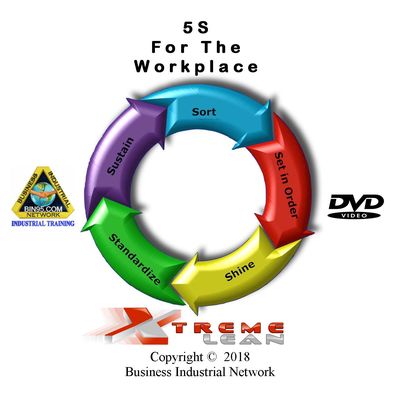
This first section of 5S is provided by – Graphic Products, Inc., Contact info@graphicproducts.com, Copyright © 2000, 2001 All rights reserved.
Sort - Systematize - Shine - Standardize - Sustain
The Five S program focuses on having visual order, organization, cleanliness, and standardization.
1. Sort
"Sorting" means to sort through everything in each work area. Keep only what is necessary. Materials, tools, equipment and supplies that are not frequently used should be moved to a separate, common storage area. Items that are not used should be discarded. Don't keep things around just because they might be used, someday.
Sorting is the first step in making a work area tidy. It makes it easier to find the things you need and frees up additional space. As a result of the sorting process, you will eliminate (or repair) broken equipment and tools. Obsolete fixtures, molds, jigs, scrap material, waste and other unused items and materials are disposed of.
2. Systematize
Step two is to organize [systematize], arrange and identify everything in a work area for the most efficient and effective retrieval and return to its proper place. Commonly used tools should be readily available. Storage areas, cabinets and shelves should be properly labeled. Clean and paint floors to make it easier to spot dirt, waste materials and dropped parts and tools. Outline areas on the floor to identify work areas, movement lanes, storage areas, finished product areas, etc. Put shadows on tool boards, making it easy to quickly see where each tool belongs.
In an office, provide bookshelves for frequently used manuals, books, and catalogs. Labels the shelves and books so that they are easy to identify and return to their proper place. The objective in this step is: A place for everything and everything in its place, with everything properly identified and labeled.
This means there are two important parts to Systematic Organization - putting everything in its proper place and setting up a system so that it is easy to return each item to its proper place. The second part is where good labeling and identification practices are important. Both the equipment/tools and materials you use, as well as their proper storage locations, need to be clearly identified and labeled. Systematic organization not only refers to individual work areas. Your overall facility should also be systematically organized, including the proper placement of easy-to-understand labels and signs. Piping, valves, control panels, major equipment, doorways, minor equipment, instruments, storage areas, offices and files should all be clearly identified.
3. Shine
Step Three: Once you have everything, from each individual work area up to your entire facility, sorted (cleaned up) and organized, you need to keep it that way. This requires regular cleaning, or to go along with our third S, "shining" things up. Regular, usually daily, cleaning is needed, or everything will return to the way it was. This could also be thought of as inspecting. While cleaning it's easy to also inspect the machines, tools, equipment and supplies you work with.
Regular cleaning and inspection make it easy to spot lubricant leaks, equipment misalignment, breakage, missing tools and low levels of supplies. Problems can be identified and fixed when they are small. If these minor problems are not addressed while small, they could lead to equipment failure, unplanned outages or long - unproductive - waits while new supplies are delivered. When done on a regular, frequent basis, cleaning and inspecting generally will not take a lot of time, and in the long run will most likely save time.
4. Standardize
Step Four: To ensure that the first three steps in your Five S program continue to be effective, the fourth step is to simplify and standardize. The good practices developed in steps 1 through 3 should be standardized and made easy to accomplish. Develop a work structure that will support the new practices and make them into habits. As you learn more, update and modify the standards to make the process simpler and easier.
One of the hardest steps is avoiding old work habits. It's easy to slip back into what you've been doing for years. That's what everyone is familiar with. It feels comfortable. Use standards to help people work into new habits that are a part of your Five S program. Any easy way to make people aware of and remind them about the standards is to use labels, signs, posters and banners.
5. Sustain
Step 5: The final step is to continue training and maintaining the standards. Have a formal system for monitoring the results of your Five S program. Don't expect that you can clean up, get things organized and labeled, and ask people to clean and inspect their areas every day -- and then have everything continue to happen without any follow-up. Continue to educate people about maintaining standards. What there are changes - such as new equipment, new products, new work rules - that will affect your Five S program and adjustments to accommodate those changes. Think of this step as sustaining the benefits you are getting from your Five S program.
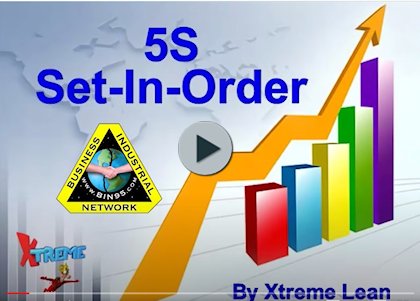
Please click on picture above to watch set-in-order video.
3.6 Watch keeping by operators
The watch keeper of old guarded their people and possessions. They were found walking about looking, listening, and watching for changes that signaled danger. Their job was to look for hazards and quickly raise the alarm before all of them were invaded and killed or captured into slavery. With sufficient warning the home group could rally to the defense and counterattack the enemy. In the world of plant and equipment maintenance the watch keeper is the plant operator.
Times haven’t changed that much. Instead of being invaded by the enemy we now get consumed by plant and equipment problems. If only there was an effective way to spot problems coming our way and mount a counterattack before being overrun.
There is a way, and it has been used since the days of the cave man – The Watch Keeper.
The plant operator is perfect for the job – he is always around the equipment, he knows when it is operating properly and when something has changed, he can go and investigate when odd things happen, and he can call in the necessary resources whenever he needs them.
The only requirement is to put the inspection process on paper. Once all the checks are written down in a list for the plant it becomes a simple job for the operators to walk around and see how things are going at the key points and equipment in the process. The watch keeping record can be handed to operators on other shifts and the recorded observations passed to supervisors and maintainers so they too can see what the operator-watch keeper has found.
A simple checklist form, three columns wide, is needed. In the first column is listed all the observations to be made. In the second column is listed what is acceptable and in the third column is space to put the operator-watch keeper’s comments of anything unusual or the actions he has taken in response to an observation. The watch-keeping sheet is then filed in the daily log for the supervisor to review.
You can make the system as fancy as you want. Vibration analyzers and temperature guns can be used. But you will never beat the observations of an experienced operator.
With this system in place the operator-watch keeper is out there looking for problems coming his way. It gives everyone the chance to defend against attack before being swamped by costly and time-wasting failures.
Operator Sensory Checks
Once an operator is out on the plant there are a lot of testing and checking that he can do with his own body. Take the example of a centrifugal pump set. Here is a list of things an operator can prove just by using his senses.
Walk up to the pump, stand beside it and look it over, listen to it and feel it. You are sensing its ‘life sounds’.
If the pump is running are the pump suction valves and discharge valves open? Is the area around the pump motor and drive well ventilated? Is the motor clear of build-up on its body – no grease over it, no dust build-up, nothing left lying on it. The motor and drive need to get rid of their heat and anything that stops heat loss must go!
Look around the coupling and under the guard if you can – are there any rubber shreds or grains of ground rubber under the guard or on the base plate? If so, the coupling is falling apart. Maybe its misalignment, maybe the rubber is degrading from chemical attack, something is definitely not right! Make sure you put the guard back in place.
Look for leaks from the back of the pump where the shaft goes through it. If the pump has a stuffing box with packing, you want to see a drop or two of product (if it’s not a dangerous chemical) every few seconds. If the pump has a flush to the seal, you want to see proof that the flush is working right. Maybe a small run-off, is there a pressure gauge or flow meter to check if a flow is present?
If the pump has a mechanical seal and you see a leak, then the seal has probably failed. It may have been put in wrong and you are seeing the consequences of that mistake. Maybe it was a wrong selection of seal materials? Is there a lot of water hammer in the piping circuit with the pressure wave causing the seal faces to open and dirty product jet out and contaminate the seal face? There are lots of reasons for seal face leaks! Is the leak destroying the pump by chemical attack? If the chemical is corrosive or hazardous then raise a work order to get it fixed fast.
You want to hear how this pump is running. If the background noise is loud then getting down and put your ears close to the pump. Start at the wet end where the liquid comes in. Is it running quiet? If you can hear a rattle sound coming from it, it is not right! A rattle is probably cavitation. Cavitation means collapsing bubbles inside the liquid jetting liquid against the impeller and volute at hundreds of feet per second speed. It rips the guts out of the impeller. Can you hear a squeal? Maybe something is rubbing? Is there a tapping sound? Is the pump producing its normal full flow? Is something caught inside the pump or piping causing a blockage? Is the strainer blocked – how do you know if it is or isn’t?
Move down to the coupling and listen. Is it noisy? It should not be. Is there a rattling sound, a buzz, a tapping? If so, the coupling maybe coming apart or it’s sitting out of square on the shafts, or it’s badly aligned on the shafts, or a bolt is loose inside it. Someone needs to look at what is causing that sound.
Then move to the drive end and again listen to the motor and/or gearbox sounds. Anything not sounding right - a squeal, a tapping noise, a rubbing noise? Get it looked at by someone that knows the equipment well.
Next you use your hands and feel for vibration and heat. Touch the wet end (if it isn’t too hot, if it is, then get a metal rod and put the rod against the volute) and sense the level of vibration. There should be none! Maybe only the smallest bit, but just barely noticeable. Any more than that and you have found a problem. Touch the base plate with your hands. There must be no vibration at all in the base plate! If the base is vibrating, then it’s a bigger problem than just the pump vibrating. You must have a solid, fixed base plate.
If the volute is hot when it should be cold because the product going through it is cold, you have found another problem. Maybe someone has left an upstream valve shut and the pump is running against a dead head!
Feel the motor around the end bearings – are they hot? Are they too hot? If you whip your hand away like a rocket, then it’s too hot. Has the motor got grease nipples? When was it last greased? Maybe too much grease? Was it the right grease? Is there a breeze blowing over the motor from the cooling fan at its end? If there should be a breeze but it’s not there has the fan been corroded away?
You probably get the idea by now how to check you pumps. This approach works for all equipment. Your body is the greatest sensing instrument you have and it’s free. Use it!
If you would like to reference this guide offline, and/or print copies for your maintenance, operators, or students in your facility, you can purchase a PDF version of this guide below.
On to chapter 4, Maintenance Management and Asset Management >>
<< Back to chapter 2, Equipment Maintenance Best Practice


